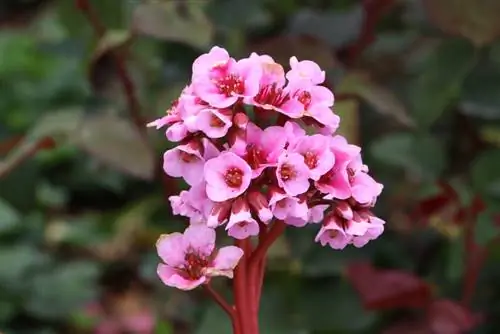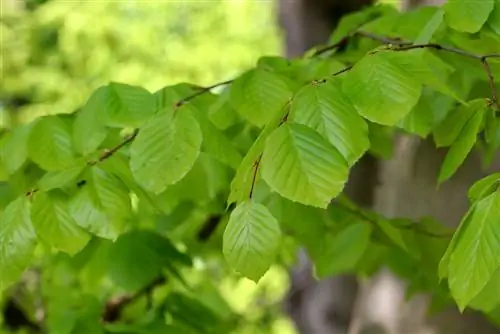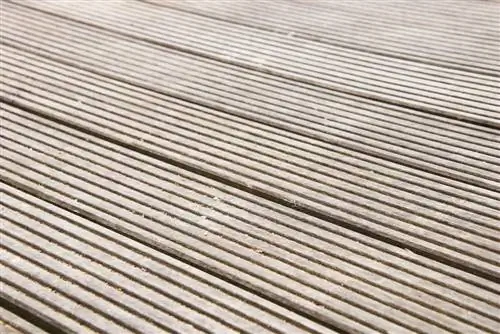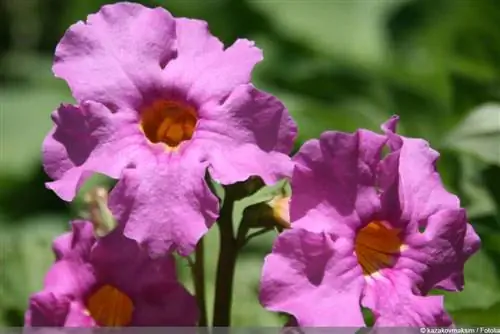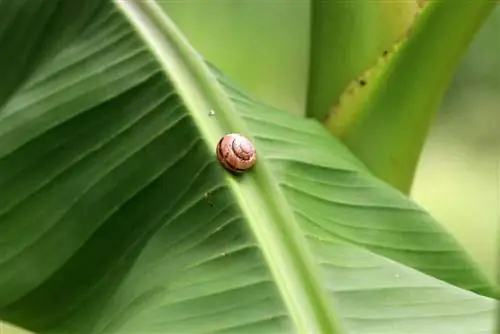- Author admin [email protected].
- Public 2023-12-17 03:39.
- Last modified 2025-01-24 12:45.
Bergenia knows how to conquer gardeners' hearts in several ways. As evergreen ornamental foliage plants, they add decorative splashes of color to the winter garden and crown their floral masterpiece with an early umbel blossom from April. Whether in the inner courtyard with little light, along the partially shaded edge of the woods or on the bank of the pond in full sun; The indestructible Bergenia have an eye-catching presence everywhere. We have put together a selection of recommended varieties for you here. Use tried-and-tested care instructions to explore the frugal requirements of the long-lasting twigs.
Care instructions
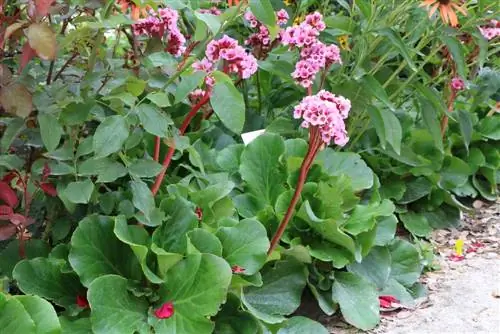
The professional care of bergenias rests on the three pillars of water, fertilizer and pruning. In addition, rejuvenation through division can be considered every few years if necessary. Otherwise, the saxifrage plant does not require any horticultural attention, but rather fulfills its floral task on its own. The following care instructions provide a brief overview of all the important details:
Location and soil conditions
It belongs in the realm of fables that bergenias only thrive as shade plants. In fact, the ornamental perennials take care of themselves in dim lighting conditions. Choose a location for Bergenia with the following ideal conditions:
- Sunny or semi-shady location up to light shade
- Nutritious, humus-rich soil
- Fresh to sandy-dry, without risk of waterlogging
A well-grown bergenia easily tolerates short-term drought, as can occur in the rock garden. However, if the plant comes under the influence of waterlogging, it has nothing to counteract this deficiency. If you arrange the ornamental leaf plant on the edge of the pond or stream, the planting site should be slightly elevated so that water can drain off easily.
Watering and fertilizing
Bergains are grateful for regular doses of water and fertilizer and do their best. Nevertheless, root vetches don't mind if they are a little drier for a short time or have to do without additional nutrients for a few weeks. If you want to do everything right, proceed like this:
- Water Bergenia regularly when the soil has dried out
- Ideally pour the water directly onto the root slice
- From March to August, fertilize every 30 days with compost, horn shavings, guano or similar fertilizer
- Pamper yourself in the bucket every 14 days with a commercially available liquid fertilizer
Stop fertilizing by September at the latest so that the perennial can mature before winter. This caution contributes significantly to improving winter hardiness.
Tip:
Solid and liquid fertilizer is best not applied to dry soil. This applies both in the bed and in the bucket. If in doubt, first water with clear water and then distribute the fertilizer or add the liquid fertilizer to the irrigation water.
Cutting
If you consistently cut off withered flower stems, this will create a well-groomed appearance and, with a little luck, attract the autumn blooms. Cut off the autumnal inflorescences as soon as possible so that the bergenias do not invest their energy in seed growth but instead have it available for the winter. In early spring, the beauty of the wintergreen foliage usually leaves a lot to be desired, so pruning close to the ground makes sense.
Tip:
A bergenia bouquet of flower stems and leaves will last in a vase for many weeks if the water is changed every few days.
Wintering
Normal winter weather does not cause any problems for Bergenia. As long as the temperatures do not fall below -28 degrees Celsius and a blanket of snow provides moisture, everything is fine for the perennial. However, if there are severe frosts or delayed ground frosts in March/April, horticultural intervention is necessary. How to do it right:
- When there is severe frost under intense winter sun, cover Bergenia with leaves and water on mild days
- In March/April, protect the flowers from nighttime ground frosts with fleece or jute
Bergenias in a pot will survive the winter he althy if the container is wrapped in bubble wrap and placed on a block of wood in front of the south wall of the house. As the evergreen foliage continues to evaporate moisture, water occasionally when there is no snow or rain.
Propagate
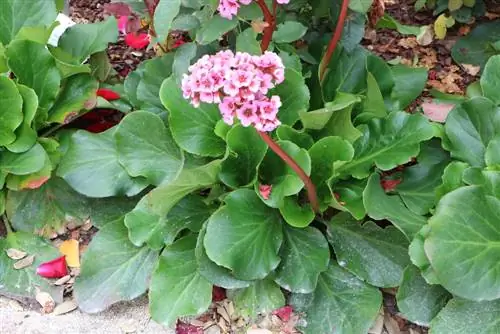
If more bergenias are desired for the garden, there are several uncomplicated methods of propagation to choose from:
- Dividing the root ball in spring or autumn
- Let root cuttings 5 cm long root in a pot with lean substrate
- Sowing seeds behind glass
Sowing the very fine, brown seeds directly into the bed is rarely successful. It's better to use the low-work winter time to grow young bergenias on the windowsill. At a constant 20 degrees Celsius and a constant water supply, the seeds germinate quickly.
Recommended varieties
Heartleaf Bergenia 'Oeschberg' (Bergenia cordifolia)
The premium variety impresses with its potential for autumnal rebloom. In addition, it decorates the winter garden with dark red, shiny metallic decorative leaves. In spring, a pink flower rises above this magnificent dress of leaves, which appears again on the garden stage in autumn after a summer pruning.
Growth height 25-40 cm
Heart-leaved Bergenia 'Rosi Klose' (Bergenia cordifolia)
It stretches up mightily and yet retains a compact habit with its round to heart-shaped leaves. From April to May, pink bell-shaped flowers unfold in abundance, towering over the beautiful foliage. Not to forget their repellent effect on voracious snails, which give the snails a wide berth.
Growth height 30-70 cm
Bergenia 'Bressingham White' (Bergenia cordifolia)
The successful breeding opens your garden season with pure white to delicate pink flowers. The bergenia fulfills this task in almost every location, from the perennial bed and the edge of the wood to the rock garden and roof garden to the balcony and the terrace. After the decorative foliage perennial enriched the summer garden with reddish-green heart-shaped leaves, it shines through the winter with bronze-colored, shiny metallic foliage.
Growth height 30-40 cm
Bergenia hybrid 'Baby Doll'
Thanks to this breeding, small gardens do not have to do without the year-round decoration of Bergenia. Due to its low height, it creates a picturesque appearance in the front garden or in the pot without appearing dominant. However, the playful umbel flowers should be protected from delayed ground frosts in April and May. If you don't want to take this risk, cut off the attractive flower stalks in good time so that they spread their magic in the vase.
Growth height 15-25 cm
Bergenia hybrid 'Biedermeier'
Here, parent plants of various Bergenia species brought their advantages and the result was a breeding with opulent splendor. From April to May, large, delicate pink bell flowers with dark red veins rise above the fresh green, elongated foliage. The leaves retain their vibrant green throughout the winter. If they are powdered with snowflakes, this creates a high-contrast appearance.
Growth height 20-30 cm
Bergenia hybrid 'Eyecatcher'
This perennial does what its variety name promises. Its bright pink inflorescences unfold from the end of March and harmonize perfectly with the reddish-brown foliage, which retains its color throughout the winter. Thanks to the stable, leathery leaf structure and creeping growth, bergenias, like 'Eyecatcher', also act as a practical ground cover that leaves no chance for weeds. This breeding comes from Rosemarie Eskuche, the German Bergenia queen.
Growth height 30-40 cm
Bergenia hybrid 'Evening Bells'
While the majority of its counterparts feature delicate pink to bright pink flowers, this cultivar impresses with dark red bell-shaped flowers that dangle close together on the strong stem. The leaves are not inferior to the intense play of colors and, after their fresh green color, take on a bright red tone in winter.
Growth height 30-40 cm
Bergenia hybrid 'Autumn Blossom'
When selecting this variety, the breeders had their sights set on a guaranteed second flowering, which is not always the case with Bergenia. If 'Autumn Blossom' is cut back to the evergreen foliage after the first flowering period, the pink bell-shaped flowers will reliably appear again in early autumn. The variety also has heart-shaped, large leaves whose serrated edges have a reddish shimmer. In late autumn, the entire foliage takes on a rich red color that remains throughout the winter.
Growth height 25-40 cm
Bergenia hybrid 'Schneekuppe'
With its pure white flowers, it provides a little variety in the red and pink colors of Bergenia. The historic variety blooms from April to May with fresh green leaves whose color hardly changes in winter. Thanks to its dense, creeping growth, the perennial keeps weeds at bay and at the same time attracts hordes of bees and butterflies with its fragrant flowers. 'Schneekuppe' is therefore the ideal root for the natural garden.
Growth height 25-35 cm
Bergenia hybrid ‘Carmen’
Another magnificent specimen from the hand of the German Bergenia queen Rosemarie Eskuche. With 'Carmen', the famous gardener created a variety whose purple-red flowers lean elegantly towards the ground to communicate with the shiny, dark green leaves. It is best to plant this perennial beauty in protected locations, such as a sunny house wall or in the protection of mighty trees.
Growth height 35-40 cm
Conclusion
Strictly speaking, it is the decorative leaves that make Bergenia so attractive. Heart-shaped, with a sawn, often shimmering red edge, they attract everyone's attention. Particularly during the barren winter period, Bergenia stands out in the bed and on the balcony with their varnished-looking splendid foliage. In early spring, when the pink, red or white umbel flowers proudly rise on the fleshy stem above the leaves, even the biggest doubters have to admit that this saxifrage plant is a flower of beauty. The effort required to care for the ornamental perennials is hardly worth mentioning. Watering when it is dry, fertilizing with compost every 3-4 weeks and pruning before the next shoots do not pose any challenge to even the debutant hobby gardener. Reproduction and rejuvenation go hand in hand. If the roots are getting old, pick up the root ball, divide it and place the segments in fresh soil.

